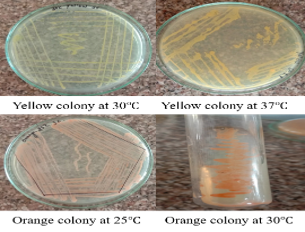Abstract
A pigment is a substance that is substantially used in different industries that come in a wide range of coloration and few of which are soluble in water. Bacterial pigments have many applications in the modern day life. Some microorganisms have the characteristics feature to produce pigments which may additionally beneficial us in identification. Bacterial pigments have larger compatibility and greater biodegradability with the environment. Nontoxic nature of pigment produced with the aid of a huge range of microorganisms make them ecofriendly for use in foodstuff, dye, cosmetics, pharmacy and different industrial purposes. Pigments of bacteria provide various advantages compared to synthetic dyes. They are biodegradable in nature, easy to extract, easily available, cheaper substrates needed. The pigment produced by the bacteria can be used as anticancer agents, antibacterial agent and anti-proliferative agents. The object of the existing find out about was once to isolated pigment producing microorganism from water and soil samples and explores their properties. Based on their morphological and biochemical characteristics, they have been recognized as Micrococcus and Arthrobacter. The pigment isolated from bacterial spp. is used for the antimicrobial activity, anti-oxidant recreation and for optimization of pH, temperature and NaCl. It was once concluded that water and soil have various microorganisms and they have the capacity of producing pigments.
Full text article
References
Bhatt, S. V., Khan, S. S., Amin, T. 2013. Isolation and characterization of pigment producing bacteria from various foods for their possible use as bocolors. International Journal of Recent Scientific Research, 4(10):1605–1609.
Chandran, M., Duraipandi, V., Yuvaraj, D., Vivek, P., Parthasarathy, N. 2014. Production and extraction of bacterial pigments from novel strains and their applications. RJPBCS, 5(6):584–593.
Fernandes, R. P. P., Trindade, M. A., Tonin, F. G., Lima, C. G., Pugine, S. M. P., Munekata, P. E. S., Lorenzo, J. M., de Melo, M. P. 2016. Evaluation of antioxidant capacity of 13 plant extracts by three different methods: cluster analyses applied for selection of the natural extracts with higher antioxidant capacity to replace synthetic antioxidant in lamb burgers. Journal of Food Science and Technology, 53(1):451–460.
Goswami, B., Bhowal, J. 2014. Identification and characterization of extracellular red pigment producing bacteria isolated from soil. Int J Curr Microbiol App Sci, 3(9):169–176.
Goswami, G., Chaudhuri, S., Dutta, D. 2010. Effect of pH and temperature on pigment production from an isolated bacterium. Chemical Engineering Transactions, 20:127–132.
Holt, J. G., Krieg, N. R., Sneath, H. A., Staley, J. T. 1994. Bergey’s Manual of Determinative Bacteriology. Williams and Wilkins U.S.A 9.
Hudzicki, J. 2009. Kirby-Bauer Disk Diffusion Susceptibility Test Protocol. American Society for Microbiology, pages 1–8.
Joshi, P. P., Yewatkar, S. K., Ghumare, R. R., Trupti, D. 2019. Isolation, Characterization of Yellow Pigments Producing Bacteria. EC Clinical and Experimental Anatomy, 2:316–322.
Joshi, V. K., Attri, D., Bala, A., Bhushan, S. 2003. Microbial pigments. Ind J Biotechnol, 2:362–371.
Joshi, V. K., Attri, D., Rana, N. S. 2011. Optimization of apple pomace based medium and fermentation conditions for pigment production by Sarcina sp. Indian J. Natural Product Res, 2:421–427.
Kumar, A., Vishwakarma, H. S., Singh, J., Dwivedi, S., Kumar, M. 2015. Microbial Pigments: Production and their Applications in Various Industries. IJPCBS, 5:203–212.
Pankaj, V. P., Kumar, R. 2016. Microbial pigment as a potential natural colorant for contributing to mankind. Res Trends Mol Biol, pages 85–98.
Raju, V. N., Radha, T. 2015. Production of Extracellular Pigment from Microbes and its Application. International Journal on Applied Bio-Engineering, 9(2):23–29.
Rajurkar, N. S., Hande, S. M. 2011. Estimation of phytochemical content and antioxidant activity of some selected traditional Indian medicinal plants. Indian Journal of Pharmaceutical Sciences, 73(2):146–146.
Ratnakaran, P., Bhoir, M., Gupta, A. D. 2020. Isolation and characterization of pigment producing bacteria isolated from waste. International Journal of Applied Research, 6(4):252–260.
Rokade, M. T., Pethe, A. S. 2016. Isolation and identification of chromogenic bacteria from various sources. European Journal of Pharmaceutical and Medical Research, 3(5):295–299.
Samyuktha, S., Mahajan, S. N. 2016. Isolation and identification of pigment producing bacteria and characterization of extracted pigments. International Journal of Applied Research, 2(7):657–664.
Sharma, D. 2014. Understanding Biolocolor-A Review. International Journal of Scientific and Technology, 3(1):295–299.
Siddharthan, N., Sandhiya, R., Hemalatha, N. 2020. Extraction and Characterization of Antibacterial Pigment from Roseomonas Gilardii YP1 Strain in Yercaud Soil. Asian Journal of Pharmaceutical and Clinical Research, 13(3):116–120.
Singh, S., Kumar, P., Gopalan, N., Shrivastava, B., Kuhad, R. C., Chaudhary, H. S. 2012. Isolation and partial characterization of actinomycetes with antimicrobial activity against multidrug resistant bacteria. Asian Pacific Journal of Tropical Biomedicine, 2(2):S1147–S1150.
Sinha, S., Choubey, S., Kumar, A. A., Bhosale, P. 2017. Identification, characterization of pigment producing bacteria from soil and water and testing of antimicrobial activity of bacterial pigments. Int. J. Pharm. Sci. Rev. Res, 42(2):119–124.
Vijayalakshmi, M., Ruckmani, K. 2016. Ferric reducing anti-oxidant power assay in plant extract. Bangladesh Journal of Pharmacology, 11(3):570.
Waghela, M., Khan, S. 2018. Isolation, Characterization of Pigment Producing Bacteria from various food samples and testing of antimicrobial activity of bacterial Pigments. DAV International Journal of Science, 7(1).
Authors

This work is licensed under a Creative Commons Attribution-NonCommercial-NoDerivatives 4.0 International License.

